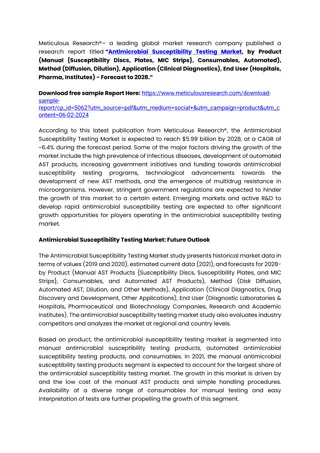Understanding Antimicrobial Agents and Their Mechanisms of Action
Antimicrobial agents play a crucial role in combating harmful microorganisms. They encompass various categories such as antiseptics, disinfectants, germicides, and bacteriostatic agents. Each category targets different types of microbes and serves specific purposes in maintaining public health standards. The mechanisms of action of these agents include oxidation, halogenation, and protein binding or precipitation. Understanding these mechanisms is essential for effective microbial control.
Download Presentation

Please find below an Image/Link to download the presentation.
The content on the website is provided AS IS for your information and personal use only. It may not be sold, licensed, or shared on other websites without obtaining consent from the author. Download presentation by click this link. If you encounter any issues during the download, it is possible that the publisher has removed the file from their server.
E N D
Presentation Transcript
Antimicrobial agents Antimicrobial agents These are the agents which cause suppression of growth of the micro organism. E.g. Kmno4,H2O2, Antiseptics: Antiseptics are the agents which are applied on living tissues to destroy or inhibit the micro-organism E.g. Hydrogen peroxide, Kmno4 ,Iodine.
Disinfectants: Disinfectants are agents which are applied on inanimate objects & kill the microbes outright. E.g. Chlorinated lime, potassium permanganate, formaldehyde, phenol etc. Sanitizers: These are disinfectants used to maintain public health standard are known as sanitizers.
Germicides The agents which kill microorganism (Germ). E.g iodine, alcohols. Bacteriostatic These are the agent which inhibiting the growth of bacteria. E.g boric acid Sterilization The process of destroying pathogenic microorganism and their products is known as sterilization.
Mechanism of action of antimicrobial agents Mechanism of action of antimicrobial agents Inorganic compounds generally exhibit antimicrobial action by any of the three mechanisms viz. (i) Oxidation (ii) Halogenation (iii) Protein binding or precipitation.
1. Oxidation: Compounds acting by this mechanism belong to class of peroxide, peroxyacids, oxygen liberating compounds like permanganate and certain Oxo- halogen anions. Microorganisms require protein for their growth. Various reducing groups are present in proteins which are oxidized by oxidizing agents.
They act on proteins containing sulfhydryl group and oxidizes free sulfhydryl to disulphide bridge and inactivate its function. Hence change in molecular shape of protein, leads to destruction of protein. Examples: Hydrogen peroxide, Potassium permanganate, non-metals act by this mechanism.
2. Halogenation: These compounds act by liberating chlorine or iodine or hypochlorite. They act on peptide linkage and change its potential and property. They cause destruction of specific functions of protein resulting in death of microorganism. E.g. Iodine & iodine preparations, chlorinated lime etc.
3. Protein Precipitation: The compounds like metal ions interact with protein. The complex formed lead to inactivation of protein. E.g. boric acid, borax, silver nitrate.
Hydrogen peroxide- Mole formula: H?O2 Mole weight: 34.01 Properties- It is colourless, odorless, transparent liquid. It has slight astringent and acid taste. It is miscible with water, alcohol and ether having a weakly acidic reaction
Chemical properties: It oxidizes potassium iodide to iodine and potassium bromide to bromine in acidic medium. When black lead sulphide reacts with hydrogen peroxide, it is oxidized to white lead sulphate. Hydrogen peroxide reduces silver oxide to metallic silver. Its dilute solution has decolorizing and bleaching actions.
Uses- Mild antiseptic. Disinfectant. Cleansing agent for cuts & wounds and for loosening ear wax. 1.6% solution is used in deodorants, gargles & mouth washes. Antidote in phosphorous & cyanide poisoning. Bleaching agent.
Storage It is stored in containers protected from light, in bottles closed with glass stoppers or plastic caps provided with a vent for the escape of oxygen. It is kept in cool place. Incompatibilities With reducing agents, oxidizing agents, alkalies and iodides, permanganates.
Assay of hydrogen peroxide. Principle: This assay is based upon the oxidation-reduction type of titration in which solution of potassium permanganate acts as an oxidizing agent and hydrogen peroxide also act as an oxidizing agent but in presence of strong oxidizing agent like potassium permanganate, hydrogen peroxide acts as reducing agent. The potassium permanganate solution acts as self indicator.
The ability of potassium permanganate solution to oxidize is due to the conversion of the MnO4- to Mn++ in acidic solution. MnO4- are purple in colour & solution of salts containing Mn++ are colourless, hence permanganate solution is decolourised by reducing agent like hydrogen peroxide. The moment there is an excess addition of potassium permanganate, solution becomes purple at the end point.. CHEMICALREACTION FORASSAY: 2KMnO4 + 3H2SO4+ 5H2O2 K2SO4 + 2MnSO4 +5O2 +8H2O
Potassium permanganate- Mole formula: KMnO4 Mole weight: 158.04 Properties- Potassium permanganate occurs in the form of dark purple colored monoclinic prisms, almost opaque with a blue metallic luster. It is odorless. An aqueous solution has sweetish astringent taste. It is water soluble and more soluble in boiling water.
Potassium permanganate is a powerful oxidizing agent. In acidic solution potassium permanganate is reduced form Mn+7 to manganous ion Mn+2 with evolution of oxygen. In neutral or alkaline media also oxygen is liberated.
Uses Topical anti-infective. Antiseptic &Antibacterial,Astringent Antidote in barbiturate poisoning. Oxidizing agent. 1:5000-1:15,000 solutions is used in cleaning wounds & ulcers. Used in mouthwashes and gargles
Storage It is kept in tightly closed container Incompatibilities With reducing agents iodides organic or oxidisable substances.
Iodine Mole formula: I2 Mole weight: 253.8 Properties- Iodine occurs as heavy, bluish black rhombic prism or plates with metallic luster. It volatilizes at ordinary temperature. It melts at higher temperature. It is practically insoluble in water but soluble in alcohol. It is freely soluble in chloroform and solvent ether.
Uses The aqueous solution of iodine are used as fungicide and germicide It is used for treatment of pharyngitis and tonsillitis In alkaloidal poisoning It is used as trace element because its deficiency may lead to goitre It is used as antiseptic and disinfectant It is used as bactericide for treatment of wounds
Storage conditions Iodine is stored in bottles with round glass stoppers in a cool place protected from light. Incompatibilities It is incompatible with hypophosphite, sulphites, some metals and reducing agents
Enlist various Iodine preparations. Aqueous Iodine Solution - It is known as Lugol's solution. Weak Iodine Solution Strong Iodine Solution Iodine tincture Iodine ointment Phenolated iodine solution Povidone-iodine- It is a member of a class of compounds known as iodophors.
Povidone Iodine solution Properties It occurs as yellowish brown amorphous powder It has slight characteristics odour Its aqueous solution is acidic to litmus It is soluble in water and alcohol and practically insoluble in organic solvent It have faint smell of iodine
Uses It is used as antiseptic and disinfectant It is used in gargles and mouthwashes Used in cut and burns Used in Eczema Storage conditions Store in airtight containers. Incompatibilities With H2O2
Advantages of povidone iodine over iodine? It is preferred over the iodine because of, Water solubility Non irritating nature Less toxicity Non staining nature It can be easily removed from skin and clothes by washing.
Chlorinated Lime Synonym - Bleaching powder Molecular formula - Ca(OCl)Cl. H2O or CaOCl2 Properties- It is a dull white powder with characteristic odor. On exposure to air it absorbs moisture & decomposes by liberating chlorine. It is sparingly soluble in water & insoluble in alcohol.
Preparation- It is obtained by action of chlorine on calcium hydroxide. This is done at 25octo minimize the formation of calcium chloride. Ca(OH)2+ Cl2 Ca(OCl) Cl + H2O
Uses- It is used as disinfectant & bleaching agent. It shows bactericidal action. It is used to disinfect urine, sputum & other organic material. It is employed for disinfecting drainages. It is a powerful bleaching agent .
It is used as one to two grams per liter for sterilization of water. Chlorinated lime is used in the preparation of surgical chlorinated soda solution, employed as a wound disinfectant
Boric acid- Synonym: Orthoboric acid. Formula: H3BO3 Mole weight:61.83 Properties: It is a white, colorless crystalline powder, odorless, unctuous to touch. It has bitter, sweetish after taste It is soluble in alcohol, freely soluble in glycerin, propylene glycol and boiling water
Stable in air, on heating at 1000Cit is converted in to metaboric acid, At 1600Cin to tetraboric acid, At more than 1600Cboric acid is converted in to boron trioxide. Boric acid is very weak acid, so it cannot be titrated accurately with standard alkali. Hence glycerin is added in its titration. Incompatibility: It is incompatible with tannins, bases.
Storage of Boric acid- It should be stored in air-tight, well closed container. Uses of Boric acid- It has weak bacteriostatic and fungistatic action It is used as local anti-infective drug in the form of cream, ointment and lotion. Buffer in topical preparations. Vehicle for ophthalmic solution. Boric acid is useful as suppositories base.
Definition of Astringent. Define as compounds that show protein precipitation by the action coagulation when applied to damage skin or mucous membrane. Properties odourless, colorless, transparent, crystalline powder. Sweet astringent taste. soluble in water & insoluble in alcohol Uses Topical astringent Mouth wash & gargles Dusting powder Styptic & antiseptic Haemostatic for cuts & ulcers
Alum Mole formula: Aluminium Ammonium sulphate (NH4).Al(SO4).12H2O Aluminium potassium sulphateAl. K (SO4).12H2O Mole wt. : 474.4 Synonym:Alumen, purified alum Properties Occurs as large crystals which are colourless. It is odourless. It has sweet astringent taste.
It is acidic to litmus. It is soluble in water and glycerine but insoluble in alcohol. On heating at it looses its water of crystallization. Uses Astringent Antiseptic for cuts and wound For purification of water Dusting powder
Protective agent for protection of skin. Dyeing industry. Hemostatic agent. Mouthwashes and gargles. Storage Alum should be stored in well closed containers Incompatibilities Alkali hydroxides carbonates borax and lime water
Zinc sulphate Mole formula: ZnSO4.7H2O Mole wt. : 287.54 Synonym: White Vitrol Properties It occurs as white crystalline powder or colourless transparent crystals. It is odourless. It has sweet astringent taste.
It is soluble in water and glycerine but insoluble in alcohol the aqueous solution of zinc sulphate is acidic to litmus. Uses Astringent Antiemetic Treatment of ulcers, infection of cornea and in conjunctivitis Granulation Healing of wound
Storage Zinc sulphate should be stored in well closed containers Incompatibilities With lead, barium, calcium, boric acid.























